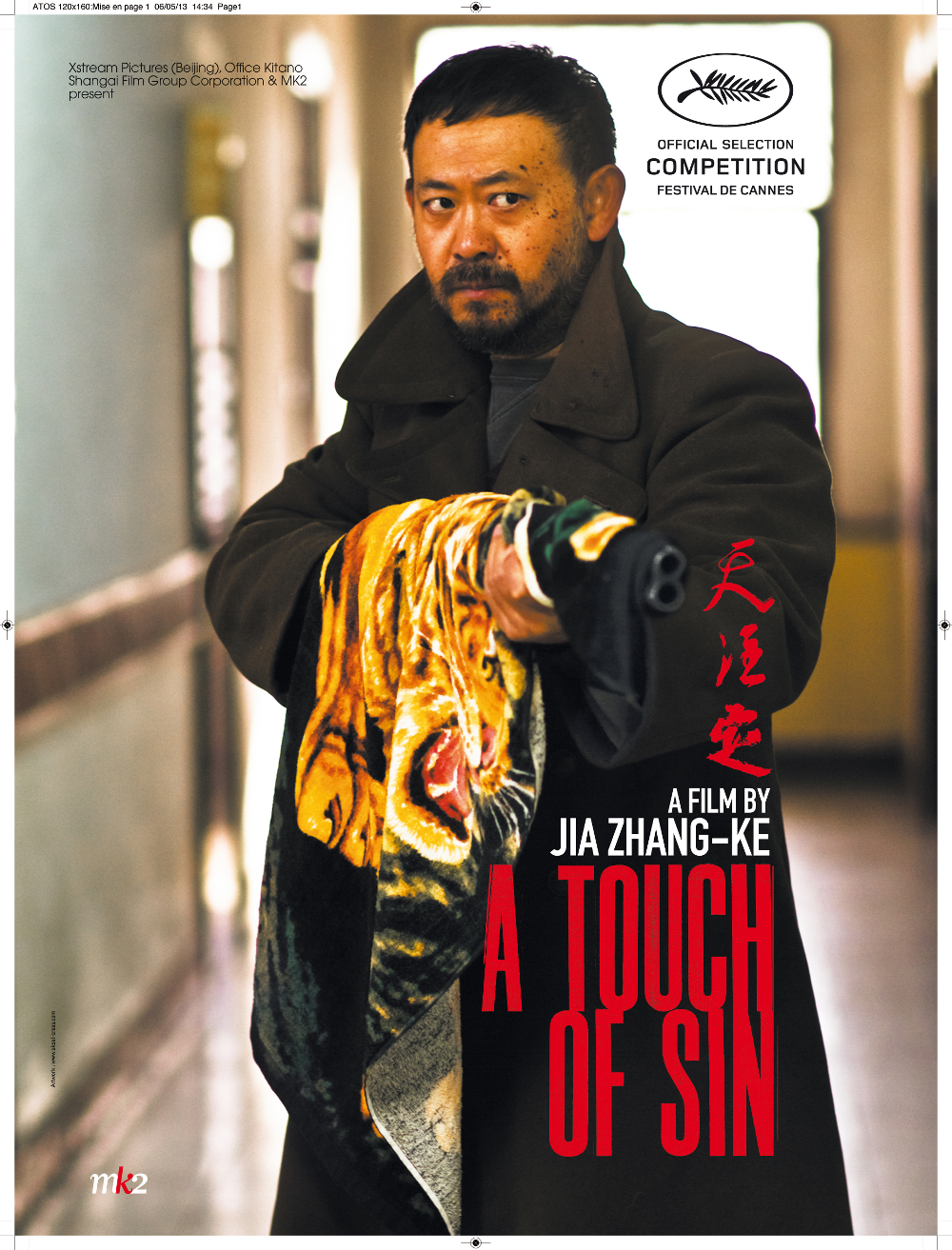NYFF51: Darkness Falls on the City [Part 2]
 In A Touch of Sin, one of the jewels in the crown of this year’s New York Film Festival, Jia Zhang-ke, widely considered China’s leading sixth generation filmmaker, continues to address the wounds inflicted by Mao’s Cultural Revolution (1966-1976) on historical continuity and individuals’ self-worth in his country. And now he has added another element: the corrupting influence of money on contemporary China and any culture obsessed by dehumanizing economic goals and values. We’re all there in one way or another, though hopefully not driven to the violent extremes of Jia’s characters. Yet, and this is Jia’s genius, at the same time that Jia chronicles desperation he keeps the film balanced by conveying a sense of the timeless wonder of life that persists despite the obscenities of this historical moment.
In A Touch of Sin, one of the jewels in the crown of this year’s New York Film Festival, Jia Zhang-ke, widely considered China’s leading sixth generation filmmaker, continues to address the wounds inflicted by Mao’s Cultural Revolution (1966-1976) on historical continuity and individuals’ self-worth in his country. And now he has added another element: the corrupting influence of money on contemporary China and any culture obsessed by dehumanizing economic goals and values. We’re all there in one way or another, though hopefully not driven to the violent extremes of Jia’s characters. Yet, and this is Jia’s genius, at the same time that Jia chronicles desperation he keeps the film balanced by conveying a sense of the timeless wonder of life that persists despite the obscenities of this historical moment.
 The film tells four stories. They all unfold against the stunning, mountainous landscape of provincial China that towers over the village through which Zhao San (Wang Baoqiang) a mysterious, predatory young cyclist, rides to attend his mother’s 70th birthday, and in which Dahai (Jiang Wu), one of the old stalwarts of Communist days, mounts a furious battle against the venal new generation of capitalists fattening themselves at the expense of working people. Sublime landscape also presents itself along the roads traveled by Xiao Yu (Zhao Tao), a pretty receptionist in an all-night sauna, to a rendezvous with her married lover and a brief visit with her poverty-stricken mother. It is visible also through the windows of the trains and vans on which the very young, increasingly desperate Xiao Hui (Luo Lanshan) travels to find work and a life for himself. The stories flow almost seamlessly into and past each other.
The film tells four stories. They all unfold against the stunning, mountainous landscape of provincial China that towers over the village through which Zhao San (Wang Baoqiang) a mysterious, predatory young cyclist, rides to attend his mother’s 70th birthday, and in which Dahai (Jiang Wu), one of the old stalwarts of Communist days, mounts a furious battle against the venal new generation of capitalists fattening themselves at the expense of working people. Sublime landscape also presents itself along the roads traveled by Xiao Yu (Zhao Tao), a pretty receptionist in an all-night sauna, to a rendezvous with her married lover and a brief visit with her poverty-stricken mother. It is visible also through the windows of the trains and vans on which the very young, increasingly desperate Xiao Hui (Luo Lanshan) travels to find work and a life for himself. The stories flow almost seamlessly into and past each other.
The opening scene sets the tone, as two of the four protagonists brush each other visually—the young cyclist and Dahai, the old curmudgeon—in the context of depersonalized violence and money that will characterize the film’s atmosphere. The cyclist is confronted by three teenagers attempting to intimidate him into giving them his money, and he guns them down ruthlessly, then casually steers his cycle past a tomato stand where Dahai and other onlookers survey a never-to-be-explained scene of mayhem: tomatoes strewn everywhere around a corpse. We seem to be in a lawless zone.
We are not. Law does exist—to protect the powerful and wealthy. As in this opening montage, the poor are battered and batter others and help never arrives. When Dahai bluntly confronts the corrupt officials of his village he is beaten bloody, and not a single objection is raised by any of the witnesses. Later in the hospital, he receives a financial reparation that, in the minds of the bureaucrats, closes the case. But Dahai and the film still have unfinished business. Human dignity is a living force for Jia, and important even if it comes in the form of grisly vengeance.
Without justifying murder in any way, Jia provides a mirror that historically documents the inevitability that individuals will fight back. As Dahai is on his way to punish the oppressive town officials, he wanders by a street theatre that has adapted for the stage an episode from the picaresque, twelfth-century martial arts epic, The Water Margin, one of the four most important works of Chinese literary history, about men who turn to crime as their only recourse in a land that offers them no justice. Fascinatingly, the epic has two different endings: one which rebukes the outlaws and another that accepts a circumstantial justification for their actions. Deftly, Jia embeds the enigmatic doubleness of The Water Margin into Dahai’s story. Both heroic and homicidal, Dahai is, at the same time, justifiable and culpable. But is he as culpable as his culture? Read on.
The stories of the cyclist and young Xiao Hui are less ambiguous aspects of a time of turmoil. Zhao is a thrill-seeking criminal, encouraged by the corruption around him. Xiao is an innocent victim of unbearable circumstances. The fourth story, though, the tale of the sauna receptionist, Xiao Yu, is Jia’s most powerful cry against contemporary mores. Xiao, worn out by her lover, his jealous wife, and the plight of her own indigent mother, comes to the end of her rope when two sauna clients mistake her for a prostitute. They assault her and, in one of the most memorable images of the NYFF, one of them strikes her relentlessly with a stack of paper bills until Xiao appears before us as an icon of suffering humanity under the tyranny of money.
 Understandably, something snaps in Xiao, and all the pride expressed in The Water Margin atavistically takes possession of her soul. Assuming the posture of a martial arts warrior, she slashes at her assailant with a pocket knife until he lies bloody at her feet. She reports herself to the police, and is next seen after she has served her jail sentence, applying for a job to the widow of one of the men killed by Dahai at the beginning of the film. Her interviewer wants assurances that Xiao’s criminal days are completely behind her, but Jia is concerned with other questions, providing a new literary mirror as Xiao comes upon a street performance, this time of a 17th century opera called The Story of Sue San, about an unjustly convicted woman. After the street actress expresses the heroine’s suffering, her judge asks whether she understands the nature of her sin. Silence is the response and a wordless close-up of Xiao’s face is the film’s final image.
Understandably, something snaps in Xiao, and all the pride expressed in The Water Margin atavistically takes possession of her soul. Assuming the posture of a martial arts warrior, she slashes at her assailant with a pocket knife until he lies bloody at her feet. She reports herself to the police, and is next seen after she has served her jail sentence, applying for a job to the widow of one of the men killed by Dahai at the beginning of the film. Her interviewer wants assurances that Xiao’s criminal days are completely behind her, but Jia is concerned with other questions, providing a new literary mirror as Xiao comes upon a street performance, this time of a 17th century opera called The Story of Sue San, about an unjustly convicted woman. After the street actress expresses the heroine’s suffering, her judge asks whether she understands the nature of her sin. Silence is the response and a wordless close-up of Xiao’s face is the film’s final image.
Jia brings depth to his stories of tension between culture and the individual by leaving open the question of Xiao’s sin—what she understands it to be and what we understand. This is liminality at its most provocative. With his literary flourishes, Jia obliquely indicts Mao for suppressing the arts, one of the few sources of illumination and comfort in times of disorientation.
Next week, in Part 3, we see NYFF go to still other dark extremes.
 This post is part of an ongoing partnership between the University of Wisconsin-Madison’s Antenna: Responses to Media & Culture and the Society for Cinema & Media Studies’ Cinema Journal.
This post is part of an ongoing partnership between the University of Wisconsin-Madison’s Antenna: Responses to Media & Culture and the Society for Cinema & Media Studies’ Cinema Journal.


